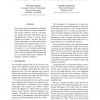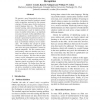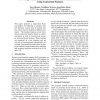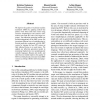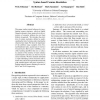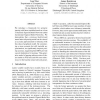84
Voted
ACL
2007
15 years 2 months ago
2007
We present a global discriminative statistical word order model for machine translation. Our model combines syntactic movement and surface movement information, and is discriminat...
133
click to vote
ACL
2008
15 years 2 months ago
2008
We present a novel hierarchical prior structure for supervised transfer learning in named entity recognition, motivated by the common structure of feature spaces for this task acr...
105
Voted
ACL
2008
15 years 2 months ago
2008
Since facts or statements in a hedge or negated context typically appear as false positives, the proper handling of these language phenomena is of great importance in biomedical t...
96
Voted
ACL
2008
15 years 2 months ago
2008
This paper proposes a novel method that exploits multiple resources to improve statistical machine translation (SMT) based paraphrasing. In detail, a phrasal paraphrase table and ...
100
click to vote
ACL
2007
15 years 2 months ago
2007
This paper proposes a supervised learning method for detecting a semantic relation between a given pair of named entities, which may be located in different sentences. The method ...
83
Voted
ACL
2008
15 years 2 months ago
2008
We improve the quality of statistical machine translation (SMT) by applying models that predict word forms from their stems using extensive morphological and syntactic information...
ACL
2008
15 years 2 months ago
2008
This paper evaluates the LinGO Grammar Matrix, a cross-linguistic resource for the development of precision broad coverage grammars, by applying it to the Australian language Wamb...
102
click to vote
ACL
2007
15 years 2 months ago
2007
We present a new approach to relation extraction that requires only a handful of training examples. Given a few pairs of named entities known to exhibit or not exhibit a particula...
89
Voted
ACL
2008
15 years 2 months ago
2008
This paper studies textual inference by investigating comma structures, which are highly frequent elements whose major role in the extraction of semantic relations has not been hi...
102
Voted
ACL
2007
15 years 2 months ago
2007
We introduce a framework for syntactic parsing with latent variables based on a form of dynamic Sigmoid Belief Networks called Incremental Sigmoid Belief Networks. We demonstrate ...
